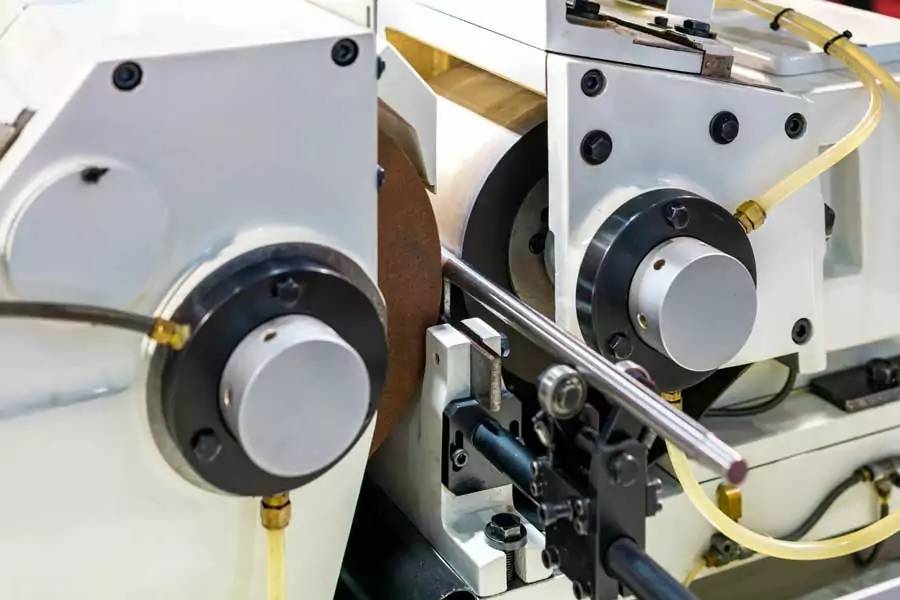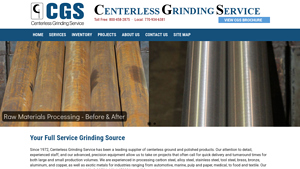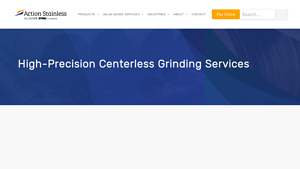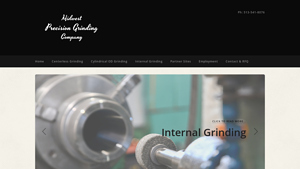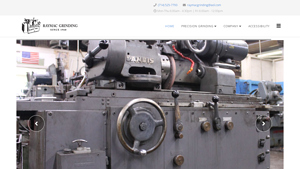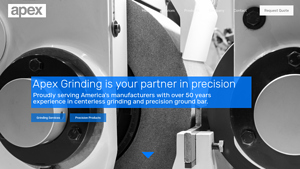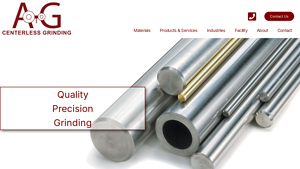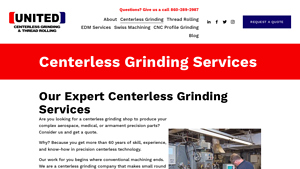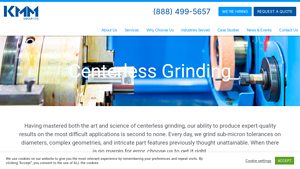Centerless Grinding Services Guide: Type, Cost, Top List…
Introduction: Navigating the Global Market for centerless grinding services
In the fast-paced world of global manufacturing, sourcing high-quality centerless grinding services poses a significant challenge for B2B buyers, particularly those operating in emerging markets across Africa, South America, the Middle East, and Europe. With industries ranging from automotive to aerospace demanding precision and efficiency, understanding the intricacies of centerless grinding becomes essential. This guide offers a comprehensive overview of the various types of centerless grinding services available, including in-feed and thru-feed processes, while also addressing applications across multiple sectors.
Buyers will gain insights into the critical factors for vetting suppliers, ensuring compliance with international standards, and optimizing production costs without compromising quality. The guide also delves into the nuances of material compatibility, lead times, and technological advancements that enhance grinding accuracy. By arming B2B decision-makers with actionable knowledge, this resource empowers them to make informed purchasing decisions that align with their operational goals. Whether you are in Vietnam navigating the complexities of local suppliers or in Saudi Arabia seeking reliable partners for high-volume production, understanding centerless grinding services is key to sustaining competitive advantage in a global marketplace.
Understanding centerless grinding services Types and Variations
| Type Name | Key Distinguishing Features | Primary B2B Applications | Brief Pros & Cons for Buyers |
|---|---|---|---|
| Thru-Feed Grinding | Continuous feeding of parts, ideal for simple, cylindrical shapes | Automotive components, fasteners, shafts | Pros: High efficiency, minimal setup; Cons: Limited to simple geometries. |
| Infeed Grinding | Parts are pressed against the wheel, suitable for complex profiles | Medical devices, aerospace components | Pros: Handles complex shapes, better tolerances; Cons: Slower than thru-feed. |
| Plunge Grinding | Grinding wheel moves vertically, ideal for specific features | Precision machined parts, custom tooling | Pros: Great for intricate designs; Cons: Longer cycle times. |
| Profile Grinding | Custom profiles and contours, flexible setup | Specialty parts, artistic components | Pros: Highly customizable; Cons: More complex setup and longer lead times. |
| Centerless Grinding | Utilizes no centers, suitable for high-volume production | General manufacturing, high-speed applications | Pros: Efficient for mass production; Cons: Requires precise part design. |
What Are the Characteristics of Thru-Feed Grinding Services?
Thru-feed grinding is characterized by its ability to continuously feed parts through the grinding machine. This method is most effective for cylindrical parts that do not require any centers. It is particularly suited for high-volume production runs, such as automotive components and fasteners. B2B buyers should consider the simplicity of the part geometry, as this method is limited to straightforward shapes. The major advantage is the high efficiency and minimal setup time, making it a cost-effective choice for manufacturers looking to optimize throughput.
How Does Infeed Grinding Differ from Other Methods?
Infeed grinding is distinct in that it allows for the grinding of parts with complex profiles and multiple diameters. The workpiece is pressed against the grinding wheel, making it suitable for intricate shapes, such as those found in medical devices and aerospace components. B2B buyers should evaluate the complexity of the parts they require, as this method excels in maintaining tight tolerances and achieving superior surface finishes. However, it may be slower than thru-feed grinding, which can impact lead times for large orders.
When Should Plunge Grinding Be Considered?
Plunge grinding involves a grinding wheel that moves vertically to grind specific features on a workpiece. This method is ideal for precision machined parts and custom tooling, where intricate designs are necessary. Buyers should consider plunge grinding when their components require detailed geometries that other grinding methods cannot achieve efficiently. While this technique offers excellent precision, it typically results in longer cycle times, which may affect production schedules.
What Are the Advantages of Profile Grinding for Custom Parts?
Profile grinding is used to create custom shapes and contours, providing a high degree of flexibility in the manufacturing process. This method is particularly beneficial for specialty parts and artistic components that require a unique design. B2B buyers should assess the need for customization in their projects, as profile grinding can accommodate a wide range of specifications. However, the setup can be more complex, resulting in longer lead times compared to standard grinding methods.
Why Choose Centerless Grinding for High-Volume Production?
Centerless grinding is a versatile technique that eliminates the need for centers, making it suitable for high-volume applications. This method is widely used in general manufacturing and high-speed applications, where efficiency and precision are paramount. Buyers should ensure their part designs are compatible with centerless grinding, as this method requires specific geometries to function optimally. The primary benefits include enhanced productivity and cost-effectiveness, although it necessitates precise design considerations to avoid production issues.
Key Industrial Applications of centerless grinding services
| Industry/Sector | Specific Application of centerless grinding services | Value/Benefit for the Business | Key Sourcing Considerations for this Application |
|---|---|---|---|
| Automotive | Grinding of carbon steel bars for engine components | Ensures precise dimensions and surface finishes for durability | Look for suppliers with experience in automotive standards and rapid turnaround capabilities. |
| Aerospace | Precision grinding of parts for aircraft systems | Provides high tolerance and reliability essential for safety | Suppliers should have certifications like AS9100 and proven track records in aerospace applications. |
| Medical Devices | Grinding of stainless steel components for surgical instruments | Guarantees cleanliness and precision critical for medical safety | Ensure compliance with ISO 13485 standards and capabilities for small batch production. |
| Marine | Grinding and polishing of propeller shafts | Enhances performance and longevity of marine equipment | Seek suppliers with expertise in corrosion-resistant materials and quick lead times for project demands. |
| Oil & Gas | Thru-feed grinding of components for drilling equipment | Reduces operational downtime with high efficiency | Consider suppliers who can handle large volumes and have robust quality assurance processes. |
How is Centerless Grinding Utilized in the Automotive Industry?
In the automotive sector, centerless grinding services are crucial for producing components like carbon steel bars that are used in engine parts and drivetrains. This process ensures that the components meet strict dimensional tolerances and surface finish requirements, which are vital for performance and longevity. International buyers should prioritize suppliers familiar with automotive standards, quick turnaround times, and the ability to handle both large and small production runs to meet varying demand levels.
What Role Does Centerless Grinding Play in Aerospace Applications?
Aerospace applications require exceptionally high precision, making centerless grinding indispensable for parts used in aircraft systems. This service provides tight tolerances and superior surface finishes, crucial for components that must withstand extreme conditions. Buyers should seek suppliers with AS9100 certifications, as this indicates adherence to industry-specific quality standards. Additionally, suppliers should demonstrate experience with high-value aerospace components, ensuring reliability and safety.
How is Centerless Grinding Applied in Medical Device Manufacturing?
In the medical device industry, centerless grinding is utilized to create stainless steel components for surgical instruments and implants. The precision and cleanliness of the grinding process are vital to ensure that these components are safe for use in medical environments. Buyers should look for suppliers compliant with ISO 13485 standards, which govern medical device quality management systems. Suppliers should also be capable of producing small batch runs to accommodate the specialized needs of medical device manufacturers.
What Benefits Does Centerless Grinding Offer in the Marine Sector?
Centerless grinding services are employed in the marine industry for grinding and polishing propeller shafts, enhancing their performance and durability against harsh marine environments. This process not only improves the surface finish but also extends the lifespan of critical components. When sourcing, buyers should consider suppliers with expertise in marine-grade materials and the ability to provide quick lead times to support maintenance schedules and equipment upgrades.
How is Centerless Grinding Used in the Oil & Gas Industry?
In the oil and gas sector, centerless grinding is essential for producing components used in drilling equipment. Thru-feed grinding allows for efficient processing of parts, minimizing operational downtime and ensuring high productivity. Buyers should prioritize suppliers capable of handling large volume requirements and maintaining rigorous quality assurance standards. Understanding the supplier’s capacity to manage fluctuating demands and ensure timely delivery is crucial for maintaining operational efficiency in this sector.
3 Common User Pain Points for ‘centerless grinding services’ & Their Solutions
Scenario 1: Delays in Production Lead Times
The Problem: A B2B buyer in the automotive industry faces a significant challenge with production delays. Their supplier of centerless grinding services has inconsistent lead times, causing bottlenecks in their manufacturing process. This unpredictability results in missed deadlines and lost contracts, as customers demand timely delivery of precision components. The buyer is left scrambling to find alternative solutions, often at a higher cost.
The Solution: To overcome delays, buyers should prioritize partnering with centerless grinding service providers who have a proven track record of reliability and quick turnaround times. When evaluating potential suppliers, request detailed lead-time commitments and assess their capacity to handle urgent requests. Establishing a clear communication channel with the supplier can also facilitate faster responses to unexpected changes in demand. Additionally, consider diversifying your supply chain by identifying multiple grinding service providers, ensuring that you have backup options in case of unforeseen delays. By implementing these strategies, buyers can maintain production schedules and meet customer expectations consistently.
Scenario 2: Inconsistent Quality of Ground Components
The Problem: A B2B buyer in the medical device sector discovers that the components they receive from their centerless grinding service vary in quality. Some parts do not meet the stringent tolerances required for medical applications, leading to increased rejection rates during quality assurance testing. This not only disrupts production but also raises concerns about compliance with industry regulations.
The Solution: To address quality inconsistencies, buyers should demand comprehensive quality assurance processes from their centerless grinding service providers. Request detailed documentation of the supplier’s quality control measures, including certifications such as ISO 9001 or AS9100, which indicate adherence to high-quality standards. Additionally, engage in proactive communication with the supplier regarding specific tolerances and surface finish requirements. Implementing regular quality audits and using statistical process control (SPC) can help monitor the grinding process and ensure compliance with specifications. Establishing a collaborative relationship with the supplier can also foster continuous improvement initiatives that enhance product quality over time.
Scenario 3: Complexity in Part Specifications
The Problem: A B2B buyer specializing in aerospace components encounters difficulties when specifying parts for centerless grinding. The complexity of the component designs, including varying diameters and intricate profiles, poses a challenge in communicating the exact requirements to the grinding service provider. This lack of clarity can lead to miscommunication, resulting in parts that do not meet the buyer’s needs.
The Solution: To mitigate issues related to complex part specifications, buyers should invest time in creating detailed technical drawings and specifications that clearly outline the requirements for centerless grinding. Utilize tools like CAD software to generate precise diagrams that highlight critical dimensions, tolerances, and surface finish expectations. When reaching out to potential grinding service providers, include these drawings along with a Request for Quotation (RFQ) to facilitate accurate quotes and understanding of the project scope. Engaging in initial consultations with suppliers can also help clarify capabilities and ensure that they can accommodate the specific requirements. By fostering an environment of clear communication and providing comprehensive documentation, buyers can significantly reduce the risk of errors and ensure successful outcomes in the grinding process.
Strategic Material Selection Guide for centerless grinding services
What Are the Key Properties of Common Materials Used in Centerless Grinding Services?
Centerless grinding services cater to a variety of materials, each with unique properties that influence their performance in specific applications. Understanding these materials is crucial for international B2B buyers to make informed decisions.
How Does Carbon Steel Perform in Centerless Grinding?
Carbon steel is a widely used material in centerless grinding due to its excellent machinability and hardness. It typically exhibits high tensile strength, making it suitable for applications requiring durability. Carbon steel can withstand significant pressure and is often treated to enhance its properties, such as through heat treatment, which increases its hardness and wear resistance.
Pros: Carbon steel is relatively inexpensive and widely available, making it cost-effective for high-volume production. It also offers good surface finishes and tight tolerances.
Cons: However, carbon steel is prone to corrosion, which may limit its use in environments exposed to moisture or chemicals. Additionally, it may require protective coatings to enhance its corrosion resistance.
Impact on Application: Carbon steel is commonly used in automotive and heavy machinery components, where strength and durability are paramount. However, buyers should consider environmental factors that may lead to corrosion.
What Advantages Does Stainless Steel Offer for Centerless Grinding?
Stainless steel is renowned for its corrosion resistance, which is a critical property for many applications, especially in the medical and food industries. Its ability to maintain integrity in harsh environments makes it a preferred choice for components exposed to moisture or corrosive substances.
Pros: Stainless steel provides excellent durability and aesthetic appeal, often requiring minimal finishing. It also offers good machinability and can achieve tight tolerances.
Cons: The primary drawback is its higher cost compared to carbon steel. Additionally, its machining can be more complex, requiring specialized tools and techniques.
Impact on Application: Stainless steel is ideal for applications in the medical and food processing industries, where hygiene and corrosion resistance are critical. Buyers must ensure compliance with relevant standards, such as ASTM A276 for stainless steel bars.
Why Choose Brass for Centerless Grinding Applications?
Brass, an alloy of copper and zinc, is another common material in centerless grinding. It is known for its excellent machinability and low friction properties, making it suitable for precision components.
Pros: Brass is relatively easy to machine and can achieve high-quality surface finishes. It also has good corrosion resistance, particularly in marine environments.
Cons: However, brass is softer than steel, which may limit its applications in high-stress environments. Additionally, it can be more expensive than carbon steel.
Impact on Application: Brass is often used in electrical components and fittings, where its conductivity and resistance to corrosion are advantageous. Buyers should consider the specific requirements of their applications, including compatibility with other materials.
What Role Does Aluminum Play in Centerless Grinding?
Aluminum is lightweight and has excellent corrosion resistance, making it a popular choice for various applications, including aerospace and automotive components. Its low density allows for the production of lightweight parts without sacrificing strength.
Pros: The primary advantage of aluminum is its excellent machinability and ability to achieve tight tolerances. It also offers good thermal and electrical conductivity.
Cons: However, aluminum can be more expensive than carbon steel and may require additional processes to enhance its surface properties, such as anodizing.
Impact on Application: Aluminum is widely used in industries where weight reduction is critical, such as aerospace and automotive. Buyers should ensure compliance with relevant standards, such as ASTM B221 for aluminum extrusions.
Summary of Material Selection for Centerless Grinding Services
| Material | Typical Use Case for centerless grinding services | Key Advantage | Key Disadvantage/Limitation | Relative Cost (Low/Med/High) |
|---|---|---|---|---|
| Carbon Steel | Automotive and heavy machinery components | Cost-effective and durable | Prone to corrosion | Low |
| Stainless Steel | Medical and food processing components | Excellent corrosion resistance | Higher cost and complex machining | High |
| Brass | Electrical components and fittings | Good machinability and surface finish | Softer, limiting high-stress applications | Med |
| Aluminum | Aerospace and automotive lightweight components | Lightweight with good machinability | Higher cost and requires surface treatment | Med |
This guide provides a comprehensive overview of material selection for centerless grinding services, helping international B2B buyers make informed decisions based on their specific application needs and compliance requirements.
In-depth Look: Manufacturing Processes and Quality Assurance for centerless grinding services
What Are the Key Stages in the Manufacturing Process of Centerless Grinding Services?
The manufacturing process for centerless grinding services involves several critical stages, each essential for achieving the desired precision and quality in the final product. Understanding these stages can help B2B buyers ensure that their suppliers adhere to best practices in the industry.
1. Material Preparation: How Is the Right Material Selected?
The first step in the manufacturing process is material preparation. Suppliers typically work with a variety of materials, including carbon steel, stainless steel, brass, and exotic metals. The selection of material is based on the specific requirements of the end product, including mechanical properties, corrosion resistance, and heat treatment capabilities.
Before grinding, materials often undergo cutting to length, deburring, and surface cleaning to remove any contaminants that could affect the grinding process. This initial preparation is crucial for ensuring uniformity and consistency in subsequent stages.
2. Forming: What Techniques Are Used for Centerless Grinding?
Centerless grinding primarily utilizes two techniques: thru-feed grinding and in-feed grinding.
-
Thru-Feed Grinding: This method is used for parts with a uniform diameter. The workpiece is fed through the machine between a grinding wheel and a regulating wheel. This setup allows for high-volume production with minimal cost, making it efficient for components with no centers.
-
In-Feed Grinding: This technique is suitable for parts with complex shapes or varying diameters. The workpiece is pressed against the grinding wheel, allowing for precision grinding of features like flats and slots. This method is often faster and more economical than multi-step processes.
Both techniques ensure tight tolerances and excellent surface finishes, making them suitable for various applications across industries.
3. Finishing: How Is Quality Achieved in the Final Stages?
After the grinding process, finishing is crucial for achieving the desired surface quality and dimensional accuracy. This may involve additional grinding, polishing, or even coating, depending on the specifications of the project. Advanced equipment, such as CNC Swiss lathes and automated finishing machines, is often employed to meet stringent requirements, especially in industries like aerospace, medical, and automotive.
What Quality Assurance Practices Are Essential for Centerless Grinding Services?
Quality assurance (QA) is a vital component of the centerless grinding process, ensuring that products meet international standards and customer expectations. Here are key aspects of QA that B2B buyers should consider when evaluating suppliers.
1. Which International Standards Are Relevant?
International standards such as ISO 9001:2015 and industry-specific certifications (e.g., AS9100 for aerospace) play a significant role in quality assurance. These standards outline best practices for quality management systems, which help suppliers deliver consistent, high-quality products.
For buyers in diverse regions such as Africa, South America, the Middle East, and Europe, it is crucial to verify that suppliers hold relevant certifications. This not only ensures compliance with global quality standards but also fosters confidence in the supplier’s ability to meet specific requirements.
2. What Are the Key Quality Control Checkpoints?
Quality control (QC) should be integrated into every stage of the manufacturing process. Key checkpoints include:
-
Incoming Quality Control (IQC): This involves inspecting raw materials upon arrival to ensure they meet specified standards.
-
In-Process Quality Control (IPQC): During manufacturing, ongoing inspections are conducted to monitor critical parameters and ensure adherence to specifications.
-
Final Quality Control (FQC): Once the manufacturing process is complete, final inspections and testing are performed before products are shipped. This may include dimensional checks, surface finish evaluation, and functional testing.
These checkpoints help identify potential issues early in the process, reducing the likelihood of defects in the final product.
3. What Common Testing Methods Are Employed?
Testing methods commonly used in centerless grinding services include:
-
Dimensional Inspection: Using calipers and micrometers to measure tolerances and ensure compliance with specifications.
-
Surface Finish Testing: Techniques such as profilometry are used to assess the surface roughness of components, which is critical for applications requiring tight tolerances.
-
Non-Destructive Testing (NDT): Methods such as ultrasonic testing or dye penetrant inspection can be employed to detect internal flaws without damaging the part.
These testing methods help ensure that the final product meets the stringent requirements of various industries.
How Can B2B Buyers Verify Supplier Quality Control?
For B2B buyers, verifying the quality control processes of suppliers is essential to ensure product reliability and compliance with industry standards. Here are actionable steps to take:
1. Conduct Supplier Audits
Regular audits of suppliers can provide insights into their manufacturing processes and quality assurance practices. During these audits, buyers should assess compliance with relevant standards, review documentation, and evaluate the effectiveness of QC measures.
2. Request Quality Control Reports
Buyers should request detailed QC reports from suppliers, which outline testing results and compliance with specified tolerances. These reports can serve as a valuable reference for evaluating supplier performance over time.
3. Engage Third-Party Inspection Services
Utilizing third-party inspection services can provide an unbiased assessment of a supplier’s quality control practices. These services can conduct independent inspections and testing, offering additional assurance to buyers regarding the quality of the products being supplied.
What Are the Nuances of Quality Control for International B2B Buyers?
International buyers must navigate various challenges related to quality control when sourcing centerless grinding services from suppliers across different regions. Key considerations include:
-
Cultural and Regulatory Differences: Understanding local manufacturing practices and regulations can help buyers set realistic expectations for quality and compliance.
-
Communication Barriers: Effective communication with suppliers is crucial for ensuring that quality standards are understood and adhered to. Buyers should establish clear lines of communication and provide detailed specifications.
-
Logistics and Shipping Considerations: The logistics involved in international shipping can impact product quality. Buyers should consider factors such as transportation methods and handling practices to minimize the risk of damage during transit.
By addressing these nuances, B2B buyers can foster successful partnerships with suppliers and ensure high-quality centerless grinding services that meet their specific needs.
Practical Sourcing Guide: A Step-by-Step Checklist for ‘centerless grinding services’
Introduction
This practical sourcing guide provides B2B buyers with a step-by-step checklist for procuring centerless grinding services. By following these actionable steps, buyers can ensure they select a supplier that meets their technical needs, quality standards, and operational efficiency, ultimately leading to successful project outcomes.
Step 1: Define Your Technical Specifications
Clearly articulating your technical requirements is essential for successful procurement. This includes specifying the dimensions, tolerances, surface finishes, and materials of the parts to be ground. Providing detailed drawings and specifications will help suppliers assess their capabilities and determine if they can meet your requirements.
- Key Considerations:
- Specify part diameters and lengths.
- Indicate any special requirements, such as heat treatment or complex profiles.
Step 2: Research Potential Suppliers
Conduct thorough research to identify suppliers that specialize in centerless grinding services. Evaluate their experience, industry reputation, and capabilities to ensure they align with your needs. A supplier with a strong track record in your industry can provide insights and reliability.
- Actionable Tips:
- Review online directories and industry associations.
- Check customer reviews and testimonials for firsthand insights.
Step 3: Evaluate Supplier Certifications
Verifying the certifications of potential suppliers is crucial for ensuring quality and compliance with industry standards. Look for certifications such as ISO 9001 and AS9100, which indicate a commitment to quality management systems and operational excellence.
- What to Look For:
- Ask for copies of relevant certifications.
- Ensure the supplier’s processes align with your industry requirements.
Step 4: Request Quotes and Compare Costs
Once you have identified potential suppliers, request detailed quotes that outline pricing, lead times, and any additional services. Comparing these quotes will help you understand the cost structure and value offered by each supplier.
- Comparison Points:
- Look for transparency in pricing and potential hidden costs.
- Consider lead times and the impact on your project timeline.
Step 5: Assess Technical Capabilities
Understanding the technical capabilities of each supplier is vital. Evaluate their equipment and technology used for centerless grinding, as well as their ability to handle your specific requirements, such as complex geometries or high-volume runs.
- Key Questions:
- What types of centerless grinding do they offer (e.g., thru-feed, infeed)?
- What is their maximum and minimum part size capability?
Step 6: Conduct Facility Visits
If possible, visit the supplier’s facility to get a firsthand look at their operations. This will provide insight into their quality control processes, equipment maintenance, and overall working environment, ensuring they meet your standards.
- What to Observe:
- Assess the cleanliness and organization of the shop floor.
- Engage with staff to understand their expertise and training.
Step 7: Establish Communication and Support
Effective communication is essential for successful collaboration. Ensure the supplier has a dedicated support team that can address your queries promptly and provide updates throughout the production process.
- Communication Best Practices:
- Establish points of contact for technical and administrative inquiries.
- Set expectations for response times and project updates.
By following these steps, B2B buyers can confidently navigate the procurement process for centerless grinding services, ensuring they select a supplier that meets their specific needs and contributes to their operational success.
Comprehensive Cost and Pricing Analysis for centerless grinding services Sourcing
What Are the Key Cost Components of Centerless Grinding Services?
Understanding the cost structure of centerless grinding services is crucial for international B2B buyers. The primary cost components include:
-
Materials: The choice of materials significantly influences the overall cost. Common materials processed include carbon steel, stainless steel, brass, and exotic metals. Prices can vary widely based on market conditions and material specifications.
-
Labor: Skilled labor is essential for operating advanced grinding machinery. Labor costs can differ based on geographic location and the complexity of the grinding process, affecting the final service price.
-
Manufacturing Overhead: This encompasses facility costs, utilities, equipment maintenance, and administrative expenses. Companies that invest in high-quality machinery and technology may have higher overhead but can offer superior precision and efficiency.
-
Tooling: The use of specialized tools and grinding wheels can add to costs. Tooling requirements often vary based on part specifications and complexity, impacting the pricing structure.
-
Quality Control (QC): Ensuring compliance with industry standards and certifications (such as ISO or MIL specs) necessitates an investment in quality assurance processes. This is particularly important for industries like aerospace and medical where precision is critical.
-
Logistics: Shipping and handling costs can vary significantly, especially for international shipments. Factors such as distance, transportation method, and customs clearance can all impact overall logistics expenses.
-
Margin: Finally, the profit margin applied by the supplier will affect pricing. Different suppliers may have varying margins based on their operational efficiencies and market positioning.
How Do Price Influencers Affect Centerless Grinding Service Costs?
Several factors can influence the pricing of centerless grinding services, including:
-
Volume and Minimum Order Quantity (MOQ): Larger orders often benefit from economies of scale, leading to lower per-unit costs. Suppliers may set a MOQ to ensure profitability, so understanding these thresholds is essential for budgeting.
-
Specifications and Customization: Customized parts or complex designs may incur higher costs due to additional labor and tooling requirements. It’s important for buyers to clearly define specifications to avoid unexpected expenses.
-
Materials: The choice of material not only affects initial costs but also influences processing difficulty and time. High-performance materials may require more advanced grinding techniques, impacting pricing.
-
Quality and Certifications: Parts requiring stringent quality standards and certifications can lead to higher costs. Buyers should assess whether these certifications are necessary for their applications.
-
Supplier Factors: The reputation and capabilities of the supplier play a crucial role in pricing. Established suppliers with advanced technology may charge a premium for their services but often provide better quality and reliability.
-
Incoterms: Understanding the shipping terms (Incoterms) is vital for international buyers. Different Incoterms can shift responsibilities and costs between buyers and sellers, affecting total pricing.
What Are the Best Buyer Tips for Negotiating Centerless Grinding Prices?
For international B2B buyers, especially those from Africa, South America, the Middle East, and Europe, effective negotiation and cost management are key. Here are some actionable tips:
-
Negotiate Based on Volume: Leverage larger order quantities to negotiate better rates. Suppliers are often willing to offer discounts for bulk purchases.
-
Focus on Total Cost of Ownership: Consider not just the initial pricing but also the long-term costs associated with quality, reliability, and potential rework. A slightly higher upfront cost may lead to lower overall expenses.
-
Understand Pricing Nuances: Familiarize yourself with the regional market dynamics, as prices can vary based on local demand and supply conditions. Engage with multiple suppliers to gauge a fair market price.
-
Clarify Specifications Early: Providing detailed specifications and requirements upfront can help avoid additional costs later in the process. Clear communication can also facilitate smoother negotiations.
-
Evaluate Logistics Options: Assess the logistics costs associated with different suppliers. Sometimes, a slightly higher service price may be justified by lower shipping costs or faster delivery times.
Disclaimer on Pricing
Please note that prices for centerless grinding services can vary significantly based on the factors discussed above. It is advisable to obtain detailed quotes from multiple suppliers to ensure competitive pricing tailored to your specific needs.
Alternatives Analysis: Comparing centerless grinding services With Other Solutions
Exploring Alternatives to Centerless Grinding Services
In the manufacturing sector, centerless grinding services are often chosen for their precision and efficiency in producing cylindrical components. However, several alternative methods can achieve similar outcomes, each with unique advantages and drawbacks. Understanding these alternatives allows B2B buyers to make informed decisions tailored to their specific production needs.
| Comparison Aspect | Centerless Grinding Services | CNC Machining | Traditional Grinding |
|---|---|---|---|
| Performance | High precision and efficiency; excellent for high-volume runs. | Versatile; capable of complex shapes and tight tolerances. | Good for general applications; less efficient for high volumes. |
| Cost | Competitive for large batches; setup costs can be high. | Higher per-part cost; economical for low to medium volumes. | Generally low initial costs; costs can rise with complexity. |
| Ease of Implementation | Requires specialized equipment and skilled operators. | Widely available; easier to integrate with other processes. | Simple setup; less specialized knowledge required. |
| Maintenance | Requires regular upkeep of grinding wheels and machinery. | Standard maintenance; less wear compared to grinding processes. | Maintenance can be labor-intensive; depends on machine type. |
| Best Use Case | Ideal for high-volume production of uniform parts. | Best for custom parts and prototypes with complex geometries. | Suitable for one-off or low-volume projects needing a quick turnaround. |
What Are the Pros and Cons of CNC Machining as an Alternative?
CNC machining is a versatile process that allows for the precise shaping of materials using computer-controlled machines. Its major advantage is the ability to create complex geometries and detailed designs, making it ideal for custom components. However, the initial setup and per-part costs can be higher compared to centerless grinding, especially for larger runs. CNC machining is generally easier to implement and maintain, making it a popular choice for manufacturers looking to streamline their production processes.
How Does Traditional Grinding Compare to Centerless Grinding Services?
Traditional grinding, which involves holding the workpiece stationary while the grinding wheel moves, is a method that has been used for years in various industries. It is often less costly to set up initially and can be used effectively for low-volume jobs. However, it is typically less efficient for high-volume production compared to centerless grinding, which excels in speed and consistency. Traditional grinding may also require more time for setup and adjustments, leading to longer lead times for production.
Conclusion: How Can B2B Buyers Choose the Right Solution?
When selecting the right grinding or machining solution, B2B buyers should consider their specific production requirements, including volume, complexity, and budget. Centerless grinding services are optimal for high-volume applications requiring precise tolerances, while CNC machining offers flexibility for custom designs. Traditional grinding may be suitable for simpler tasks or lower production volumes. By thoroughly evaluating the pros and cons of each method, buyers can align their choice with their operational goals, ensuring efficiency and cost-effectiveness in their manufacturing processes.
Essential Technical Properties and Trade Terminology for centerless grinding services
What Are the Key Technical Properties in Centerless Grinding Services?
Understanding the technical specifications of centerless grinding services is crucial for B2B buyers, as these properties directly impact the quality, efficiency, and suitability of the grinding process for various applications. Here are some essential specifications:
-
Material Grade
– Definition: The type of material being processed, such as carbon steel, stainless steel, or aluminum.
– Importance: Different materials have unique properties that affect grinding techniques and outcomes. Selecting the appropriate material grade ensures compatibility with the intended application, whether it’s for automotive components or medical devices. -
Tolerance
– Definition: The allowable deviation from a specified dimension, often expressed in micrometers (µm) or inches.
– Importance: Tight tolerances (e.g., ±0.0001″) are crucial in high-precision industries like aerospace and medical, where even minor deviations can lead to product failure or safety issues. Understanding tolerance levels helps in selecting the right service provider for specific requirements. -
Surface Finish
– Definition: The texture of the finished surface, typically measured in Ra (roughness average).
– Importance: A finer surface finish (e.g., 0.15 µm Ra) reduces friction and enhances the performance of components in applications where smooth operation is critical, such as in pumps or bearings. -
Part Diameter and Length
– Definition: The range of diameters and lengths that the grinding service can accommodate.
– Importance: Understanding the specifications for part diameter (from 1.65 mm to 38.1 mm) and length (up to 12 feet) helps buyers assess whether a service can handle their specific parts, which is especially important for custom projects. -
Production Lead Time
– Definition: The time required from order placement to the delivery of finished parts.
– Importance: Short lead times (as quick as 24 hours) can be a competitive advantage in industries where speed to market is essential. Knowing production capabilities allows buyers to plan their supply chains more effectively.
What Are Common Trade Terms in Centerless Grinding Services?
Familiarity with industry jargon is essential for effective communication and negotiation in the B2B space. Here are some commonly used terms:
-
OEM (Original Equipment Manufacturer)
– Definition: A company that produces parts or equipment that may be marketed by another manufacturer.
– Importance: Understanding OEM relationships helps buyers identify potential suppliers who can meet their specific component needs, especially for replacement parts or new product lines. -
MOQ (Minimum Order Quantity)
– Definition: The smallest quantity of a product that a supplier is willing to sell.
– Importance: Knowing the MOQ is vital for budgeting and inventory management. It helps buyers assess whether a supplier aligns with their production needs, particularly for smaller projects. -
RFQ (Request for Quotation)
– Definition: A document sent to suppliers requesting pricing and terms for specific goods or services.
– Importance: An RFQ streamlines the procurement process, allowing buyers to compare offers from different suppliers and negotiate better terms based on detailed specifications. -
Incoterms (International Commercial Terms)
– Definition: A series of international sales terms that define the responsibilities of buyers and sellers in shipping goods.
– Importance: Understanding Incoterms helps buyers clarify shipping responsibilities, costs, and risks associated with the transportation of parts, ensuring smoother international transactions. -
Thru-Feed Grinding
– Definition: A centerless grinding process where parts are fed continuously through the grinding machine.
– Importance: This method is ideal for high-volume production runs, allowing for efficient processing and cost savings, making it a preferred choice for many manufacturers. -
In-Feed Grinding
– Definition: A method where the part is pressed against the grinding wheel, typically used for complex shapes.
– Importance: This process allows for greater precision in achieving specific geometries, crucial for components that require multi-diameter grinding or unique profiles.
By understanding these technical properties and trade terms, B2B buyers can make informed decisions that align with their operational needs and quality standards in centerless grinding services.
Navigating Market Dynamics and Sourcing Trends in the centerless grinding services Sector
What Are the Key Drivers and Trends Influencing the Centerless Grinding Services Market?
The global centerless grinding services market is experiencing robust growth driven by advancements in manufacturing technologies and increasing demand for precision-engineered components across various industries. Key sectors such as automotive, aerospace, medical devices, and electronics are particularly reliant on high-quality grinding services to meet stringent performance standards. As international B2B buyers from regions like Africa, South America, the Middle East, and Europe increasingly seek suppliers who can provide rapid prototyping and just-in-time delivery, the emphasis on agility and responsiveness in service offerings has become paramount.
Emerging technologies, including automation and AI-driven analytics, are reshaping the landscape. These innovations enhance operational efficiency, reduce lead times, and improve quality control measures. Moreover, the rise of Industry 4.0 has encouraged manufacturers to integrate smart technologies into their grinding processes, allowing for real-time monitoring and adjustments. B2B buyers should look for suppliers who are not only equipped with advanced machinery but also demonstrate a commitment to continuous improvement and innovation.
Additionally, the shift toward custom solutions and smaller batch sizes is becoming more pronounced. Buyers are increasingly prioritizing suppliers that offer flexible, scalable solutions capable of handling a diverse range of materials—ranging from carbon steels to exotic alloys. The ability to provide tailored services that align with specific project requirements can be a significant differentiator in the competitive global marketplace.
How Are Sustainability and Ethical Sourcing Impacting Centerless Grinding Services?
As environmental concerns continue to rise globally, sustainability has become a critical factor in the sourcing of centerless grinding services. B2B buyers are increasingly demanding suppliers that prioritize eco-friendly practices, such as minimizing waste and reducing energy consumption during the grinding process. The adoption of advanced technologies, such as energy-efficient machinery and recyclable materials, can significantly reduce the environmental footprint of centerless grinding operations.
Moreover, ethical sourcing is gaining traction as international buyers seek to establish transparent supply chains. Suppliers who can demonstrate compliance with international environmental standards and ethical labor practices are more likely to attract business from conscientious buyers. Certifications such as ISO 14001 (Environmental Management) and ISO 9001 (Quality Management) are becoming essential for companies aiming to showcase their commitment to sustainability and ethical practices.
The use of ‘green’ materials in grinding processes is also emerging as a trend. This includes the adoption of biodegradable coolants and lubricants, which not only enhance the grinding process but also align with global sustainability goals. B2B buyers should prioritize suppliers who are actively investing in sustainable practices and can provide documentation of their environmental impact.
How Has the Centerless Grinding Services Sector Evolved Over Time?
The evolution of centerless grinding services can be traced back to the early 20th century, where the need for precision machining began to gain momentum alongside industrialization. Initially, grinding was a labor-intensive process, but technological advancements led to the development of specialized machines that significantly increased efficiency and precision.
Over the decades, the introduction of CNC (Computer Numerical Control) technology revolutionized the industry, allowing for automated and repeatable grinding processes that meet tight tolerances. This technological shift not only improved the quality of finished products but also expanded the capabilities of centerless grinding, enabling manufacturers to handle a wider variety of materials and complex geometries.
Today, the centerless grinding sector continues to adapt to changing market demands, incorporating advanced technologies such as automation, IoT, and real-time data analytics. This evolution reflects a broader trend in manufacturing towards greater efficiency, customization, and sustainability, ensuring that centerless grinding remains a vital service in the global supply chain.
Frequently Asked Questions (FAQs) for B2B Buyers of centerless grinding services
-
1. How can I ensure quality in centerless grinding services?
To ensure quality in centerless grinding services, verify that the supplier adheres to recognized industry standards such as ISO 9001 and other relevant certifications. Request detailed documentation of their quality assurance processes, including inspection methods and equipment used. Engage in initial samples or prototypes to evaluate the precision and surface finish of their work. Establish clear communication regarding your specifications and expectations, and consider periodic audits or visits to the facility to assess their operations firsthand. -
2. What types of materials can be processed through centerless grinding?
Centerless grinding is versatile and can process a variety of materials including carbon steel, stainless steel, alloy steel, brass, bronze, aluminum, copper, and even exotic metals. When sourcing services, confirm that the supplier has experience with the specific materials relevant to your projects. Different materials may require unique grinding techniques or equipment, so it’s essential to discuss your needs with the supplier to ensure they can accommodate your material requirements. -
3. What is the typical lead time for centerless grinding services?
Lead times for centerless grinding services can vary based on the complexity of the project and the supplier’s current workload. Generally, many suppliers can provide lead times as short as 24 hours for standard components. For larger or more complex orders, lead times may extend to several weeks. When sourcing, always inquire about estimated delivery times and any potential for expedited services, especially if you are working on tight project timelines. -
4. What are the minimum order quantities (MOQs) for centerless grinding services?
Minimum order quantities for centerless grinding services can differ significantly among suppliers. Some may accept low-volume orders for prototypes or specialized projects, while others may require larger batch sizes to make the project economically viable. When engaging with a supplier, clearly communicate your volume needs and ask about their MOQs to avoid any misunderstandings that could affect your production schedule. -
5. How can I customize centerless grinding services to meet my specific needs?
Customization in centerless grinding services is often possible, depending on the supplier’s capabilities. Discuss your specific requirements, such as dimensions, tolerances, and surface finishes, with potential suppliers. Many companies offer various grinding techniques, including infeed and thru-feed grinding, which can be tailored to your project. Additionally, inquire about their ability to handle secondary operations if your components require additional processing after grinding. -
6. What payment terms should I expect when sourcing centerless grinding services?
Payment terms for centerless grinding services can vary by supplier and region. Typically, terms may range from upfront payment for smaller orders to net 30 or 60 days for larger contracts. It’s essential to discuss and agree upon payment terms in advance to ensure smooth transactions. Additionally, consider the implications of international payment methods and currency exchange rates if sourcing from suppliers in different regions. -
7. How do I vet suppliers for international centerless grinding services?
When vetting suppliers for international centerless grinding services, start by researching their reputation through online reviews and industry references. Request case studies or examples of previous work relevant to your needs. Engage in direct communication to assess their responsiveness and willingness to address your concerns. Additionally, verify their certifications and compliance with international quality standards to ensure they meet your expectations for quality and reliability. -
8. What logistics considerations should I be aware of when sourcing centerless grinding services internationally?
Logistics play a crucial role in international sourcing of centerless grinding services. Consider the shipping methods and costs, as well as customs regulations in your country. Discuss delivery timelines with suppliers and factor in potential delays due to customs clearance or transportation issues. It’s also advisable to establish a clear return policy for defective or unsatisfactory products. Collaborating with a logistics partner familiar with international trade can further streamline the process.
Important Disclaimer & Terms of Use
⚠️ Important Disclaimer
The information provided in this guide, including content regarding manufacturers, technical specifications, and market analysis, is for informational and educational purposes only. It does not constitute professional procurement advice, financial advice, or legal advice.
While we have made every effort to ensure the accuracy and timeliness of the information, we are not responsible for any errors, omissions, or outdated information. Market conditions, company details, and technical standards are subject to change.
B2B buyers must conduct their own independent and thorough due diligence before making any purchasing decisions. This includes contacting suppliers directly, verifying certifications, requesting samples, and seeking professional consultation. The risk of relying on any information in this guide is borne solely by the reader.
Top 8 Centerless Grinding Services Manufacturers & Suppliers List
1. Centerless Grinding Service – Precision Grinding & Polishing
Domain: centerlessgrind.com
Registered: 1999 (26 years)
Introduction: Centerless Grinding Service offers precision grinding, polishing, and straightening services for various materials including carbon steel, alloy steel, stainless steel, tool steel, brass, bronze, aluminum, copper, and exotic metals. They cater to industries such as automotive, marine, pulp and paper, medical, food, and textile. Their services include grinding and polishing of stainless steel boat …
2. Action Stainless – Precision Centerless Grinding Services
Domain: actionstainless.com
Registered: 1999 (26 years)
Introduction: Precision Centerless Grinding Services for Stainless Steel, accommodating diameters from 0.25″ to 9.5″ and lengths up to 24′. Tolerance of +/- .0005″ and surface finish as good as 5 RMS (RA). Pump Shaft Quality (PSQ) with straightness up to .0005″ per ft. Metric sizes available. Value-added services include shear cutting, robotic welding, plate rolling, press brake forming, saw cutting, plasma cut…
3. Midwest Precision Grinding – Precision Cylindrical and Centerless Grinding
Domain: mpgrinding.com
Registered: 2021 (4 years)
Introduction: Midwest Precision Grinding specializes in high quality, precision cylindrical and centerless grinding for materials including tool steel, carbon fiber, some types of ceramic materials, plastic, chrome, and aluminum. They manufacture parts and components for the medical, food, machine building, and government markets. Services offered include:
– Cylindrical OD Grinding: 14″ Dia x 8ft Long
– Int…
4. Raymac Grinding – Precision Grinding Services
Domain: raymacgrinding.com
Registered: 2010 (15 years)
Introduction: Raymac Grinding offers precision grinding services including Centerless Grinding (Thrufeed & Infeed), Honing, Thread Rolling, and Surface Grinding. Centerless Grinding is suitable for cylindrical parts made from ferrous and non-ferrous materials, utilizing abrasive materials like polycrystalline diamond and cubic boron nitride. Honing improves out-of-roundness and taper for high-performance compon…
5. Apex Grinding – Precision Components
Domain: apexgrinding.com
Registered: 2018 (7 years)
Introduction: Precision components made with high quality materials including shafts, pins, blanks, and fasteners. Grinding and final inspection are performed in-house. Services offered include throughfeed grinding, infeed grinding, bar grinding, and OD/ID grinding.
6. A&G Centerless Grinding – Precision Ground Bar Materials
Domain: agcenterless.com
Registered: 1998 (27 years)
Introduction: A&G Centerless Grinding provides precision centerless ground bar materials and grinding services. They offer In-Feed Grinding, Precision Ground Bar Grinding, and Thru Feed Grinding. The company supplies ground bars and shafts that are cut to length for close tolerance machining applications. Established in 1979, A&G Centerless Grinding serves industries including Aerospace, Defense, New Technologi…
7. United Centerless Grinding – Precision Grinding Services
Domain: unitedcenterlessgrinding.net
Registered: 2010 (15 years)
Introduction: Expert Centerless Grinding Services including infeed grinding, thru feed grinding, form grinding, and crush grinding. Tolerances to ±.00005″ for complex cylindrical, screw machined, formed, stepped, and conical shapes. Capabilities include bar grinding lengths up to 30′, 5.5″ diameter bar capacity (1,000 lb. max/bar), computer process planning, and both short and long-run productions. AS9100D and …
8. KMM Group – Ultra-Precision Centerless Grinding Services
Domain: kmmgrp.com
Registered: 2020 (5 years)
Introduction: Centerless Grinding Services: Ultra-Precision Centerless Grinding with tolerances on diameter size and cylindricity to sub-micron levels. OD tolerances to ± .00002″ (.5 micron), Roundness to .000015″ (.35 micron), Surface finishing to < 2 Ra (.05 micron), Diameter sizes to .750″, Lengths to 10″. Precision Centerless Grinding with Thrufeed capacities from .005″ to 2.50″ and Infeed capacities from ….
Strategic Sourcing Conclusion and Outlook for centerless grinding services
In summary, the strategic sourcing of centerless grinding services offers B2B buyers a pathway to enhanced precision, efficiency, and cost-effectiveness. By leveraging advanced grinding technologies, such as thru-feed and in-feed methods, businesses can achieve tight tolerances and superior surface finishes that are critical across diverse industries, including automotive, aerospace, and medical. The ability to source these services from reliable providers not only ensures quality but also facilitates quicker turnaround times, making it essential for companies aiming to maintain a competitive edge.
As international buyers from regions like Africa, South America, the Middle East, and Europe explore their options, it is crucial to partner with service providers who demonstrate a commitment to quality standards, such as ISO certifications and robust quality assurance processes. Engaging with suppliers that offer flexible inventory control and rapid response times can significantly enhance operational efficiencies.
Looking ahead, the demand for high-quality centerless grinding services is poised to grow, driven by advancements in manufacturing technologies and increasing industry requirements. To stay ahead of the curve, B2B buyers should proactively evaluate their sourcing strategies and foster relationships with capable grinding service providers. Embrace this opportunity to optimize your supply chain and elevate your product quality.
